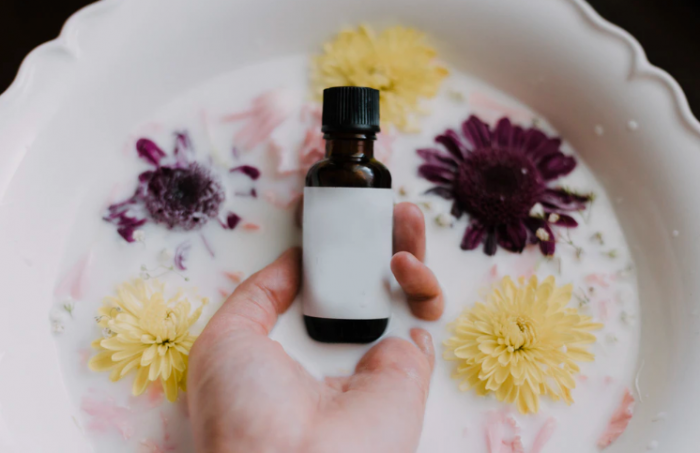“Healing with the clean, pure, beautiful agents of nature is surely the one method of all which appeals to most of us” ~ Dr. Edward Bach, 1936
~
I first learned about Bach’s Rescue Remedy when I was just starting my career as a concert pianist.
I would be overtaken by nerves and the only saving grace for my ice-cold hands was somewhere with running hot water.
When I couldn’t find a sink that was accessible from backstage, my heart would start racing, and its manic rhythms would take me out of the music. It’s like having two metronomes go off at the same time. Then came the cold sweat from my palms through to my fingertips, causing them to slip and slide in the most disastrous ways, announcing the arrival and impact of each nerve.
My confidence for anything with visual flair would be shot as both cause and effect for missing my landings when I took dramatic leaps. When I shared how crippling this was becoming, a speaker friend recommended this miracle product, and it has been a part of my arsenal ever since.
Although I’ve become familiar with a wider range of Flower Remedy products over the years, I wasn’t aware of it being a part of a healing system. Until one day earlier this year, when I wandered into a healing center in a remote Mayan village, the flower remedies became a familiar sight in an unfamiliar place. It was the only thing I recognized.
A therapist had assembled the entire literature and history on these 38 flower remedies into a book, and page by page, I stayed there for hours just studying what I wish I had known much earlier. The more I learned about it, the more compelled I am to share what I have learned with everyone around me. What’s purer than a gift of flowers?
Or does city-living preclude us from nature so much that we automatically reach for pills over flowers?
The remedy guide reads like a personality test in many ways, as it’s based on moods and emotions. I’m a huge advocate for taking (good) tests periodically because that’s one way to assess where we are and how we are feeling. Tests give us an opportunity to check in with ourselves, take inventory, and reflect. In the digital age of constant distractions, how often do we really still ourselves to listen to what our feelings are telling us? How many of us can truly locate our feelings and emotions and identify what they are and where they are coming from?
It sounds a lot easier than it is—the identification of our true feelings. It requires courage, confrontation, and clarity, all of which life’s social norms have erased and softened over time. As such, it’s important to note the distance between surface feelings versus true, deep, vulnerable feelings. When we are most vulnerable, our surface feelings tend to be most violent. This is our survival instinct, and most of us are programmed this way. This is why we argue and fight and lose our cool. But when we are enraged, what are we truly feeling?
It all comes down to variations of pain. Whether we become depressed or violent, the source of these emotions is the same. Surface feelings are merely symptoms and reactions to our pain points and triggers. When we feel bad, most of us cannot describe what this “bad” is. When we are down, most of us cannot describe what this “down” is. It took me many sessions with a psychotherapist to be able to identify vaguely what I’m feeling, at different levels, because emotions and moods are very much layered in structure.
There is always something deeper.
We are complex beings unable to identify the makeup of our cocktail of blues, so when we see these 38 flower remedies, clearly labeled which moods they are to treat, this helps us identify which one is the one bringing us down. “Name your demons” as so many professionals have said. Because the identification of what is hurting us is the first step toward healing. Clarity is the first sign of improvement when we feel bogged down, isn’t it?
Once we’ve identified what we are feeling, the flower remedy system becomes easier to navigate, because it’s essentially emotional vibrational medicine. We all carry energy, and the flowers are no different. The energy of the flowers becomes a catalyst for emotional, mental, and energetic processes that we all experience.
When I wandered into the healing center, I didn’t have a treatment scheduled. Yet, the hours I spent there has given me the resources of not one but two healing systems. To accompany the 38 flower remedies, there was a small booklet of powerful affirmations by Hugh MacPherson. When we are feeling blue, but don’t have access to flowers or the flower remedies, simply read out loud this booklet of affirmations, use them as mantras, and feel the energy they carry through us.
These are the ones I wrote down by hand and carry with me always:
Agrimony:
I am at peace with myself.
I show others who I really am.
I am honest with myself and others.
I enjoy my own company.
I hold firm when in conflict.
Cerato:
I trust my own thinking.
I know what is right for me.
I trust my intuition.
I hold myself in high esteem.
I have the courage of my convictions.
Rock Rose:
My spirit lives.
I’m ready for anything.
I have unshakeable courage in a crisis.
I am in touch with my inherent power.
Every flower is for a different mood. Every remedy lifts us from a different place of pain. Perhaps you’ll find yourself choosing flowers more consciously. Perhaps you’ll place the image of that flower along with its affirmation by your mirror or desk. Perhaps you’ll have a healing garden.
However you decide to acquaint yourself with these flower remedies and affirmations is up to you. I speak as someone who has benefited from this system, and wherever you are in your emotional journey, I hope this can reach you and lift you up.
~







Read 0 comments and reply